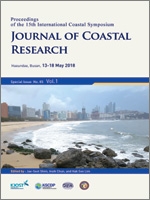Kim, S. and Lee, H.S., 2018. Combined approach of empirical mode decomposition and artificial neural network for sea-level record analysis. In: Shim, J.-S.; Chun, I., and Lim, H.S. (eds.), Proceedings from the International Coastal Symposium (ICS) 2018 (Busan, Republic of Korea). Journal of Coastal Research, Special Issue No. 85, pp. 1091–1095. Coconut Creek (Florida), ISSN 0749-0208.
In this study, we illustrate artificial signal tests analysis implying sea-level records analysis (Visser, Dangendorf and Petersen, 2015) with improved empirical model decomposition (EMD) and artificial neural network (ANN) for predicting the non-linear process of sea-level in terms of predicting a non-linear intrinsic mode for missed data and a non-linear trend. The EMD is intuitive, direct, and adaptive method for decomposing a signal into intrinsic modes, and does not require any predetermined parametric functions for analyzing a non-linear and non-stationary data. The ANN is one of machine learning methods to estimate stationary or non-stationary patterns/values. In our analyses, an artificial signal and sea-levels are decomposed into intrinsic modes, and then mainly low frequency modes are tested with ANN for predicting missing parts and for estimating future variabilities. Our results show that the combination of improved EMD and ANN is highly capable of predicting non-linear processes of sea-levels and can be applicable not only for predicting a missing data but also for estimating long-term natural variabilities and a trend.





